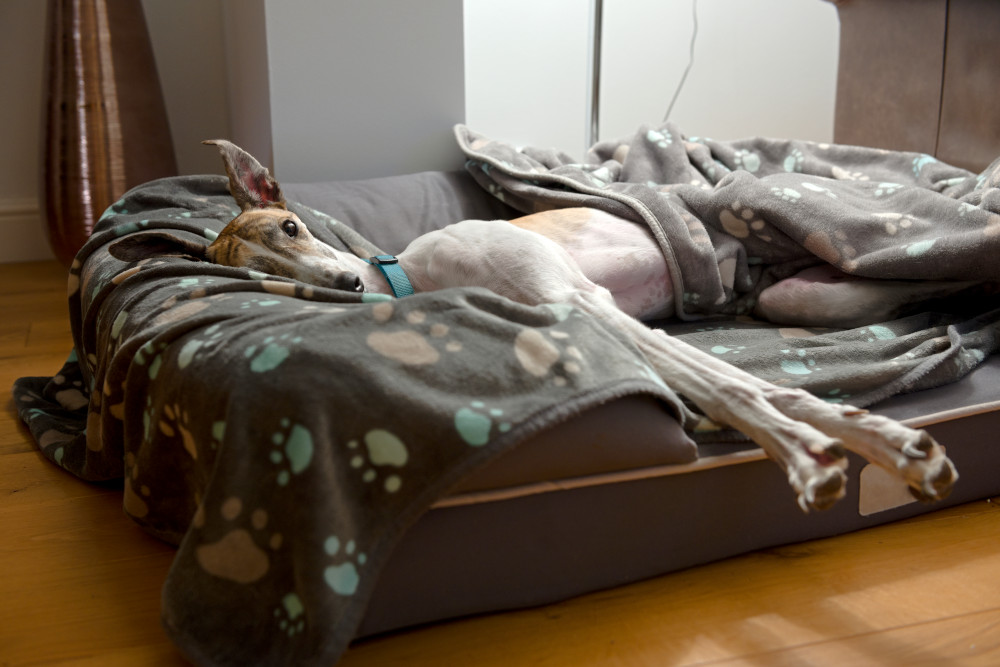
Adopted greyhounds can do amazingly well considering that many are considerably disadvantaged by their start in life. Their different early life experiences, confinement, and often limited socialisation means they have to learn to interpret the body postures, actions, words and asks of their new family whilst simultaneously trying to get used to life in their new home. Most other dogs get the opportunity to do this much earlier in life.
Most problematic behaviours are actually normal dog behaviours, which can create a problem when they are living with us. These include mouthing, chewing, barking, digging and jumping up. Unlike other breeds, greyhounds also have a tendency for collecting things.
Most problematic behaviours in greyhounds are founded in fear, anxiety and the uncertainty of an unfamiliar environment. This is likely due in part to genetics, but mainly due to a lack of early and appropriate socialisation to the domestic environment. For many paddock-raised dogs who are never trained or raced, this fear of unfamiliar situations includes interacting with people.
Always rewarding your dog when they show desirable behaviours will help to strengthen your bond with them and improve the understanding between you and your greyhound. Don’t forget to tell them they are wonderful when they are doing something you like! For more information, see this article: How do I best communicate with my dog?
Patient and consistent use of reward-based training, where you reward desirable behaviours with treats and praise, is the most humane and effective way of training dogs and addressing any unwanted behaviours. It is also enjoyable for your dog and positively enhances your relationship with them. See the following article for more information: What is the best way to train my adopted greyhound? and What is reward-based dog training and why does the RSPCA support it? Providing consistent and predictable positive feedback to your greyhound will help them become more certain about how to behave and give them confidence. Never use any form of aversive technique or physical punishment; for example, spray bottles, time out or other punishment. Chastisement (e.g., yelling at your dog or even saying ‘no’ in a firm serious tone) can lead to conflict, anxiety and uncertainty, particularly if your dog does not understand what you want them to do. Inconsistency in your response to different behaviours is also very confusing to dogs, such as chastising them for one behaviour but rewarding them for another (use of both rewards and punishment is sometimes referred to as ‘balanced training’ and should be avoided).
If your greyhound is displaying an undesirable behaviour that is increasing in severity or frequency, or you just need help, then it is time to contact a veterinary behaviour consultant who uses reward-based training for assistance. They will do a physical examination and perhaps some tests to ensure there is no underlying health issue contributing to, or causing, the problem. For example, inappropriate urination may be due to a bladder infection. The veterinary behaviour consultant will develop a tailormade humane behaviour modification program and can also help advise on additional tools that may be helpful. For example, if your dog is fearful and anxious, medication may help them modify their behaviour with less stress.
Fear and anxiety can manifest in different ways. Please seek advice from a veterinary behaviour consultant who uses reward-based training if your greyhound is showing signs of anxiety such as:
- Separation anxiety/distress, such as vocalising in your absence
- Freezing on walks
- Sleep aggression (aggression associated with the dog being startled when they are woken suddenly from sleep)
- Resource guarding (aggression associated with food or toys, etc)
- Excessive fear
- Difficulty in toilet training
- Growling and lunging at people within the home
- Inter dog aggression (with familiar and/or unfamiliar dogs)
- Destructive behaviour
For further information, read the articles Understanding anxiety and its implications for pet greyhounds and Why do greyhounds need help with toilet training?
Mouthing and nipping
Mouthing is a common way for a dog to explore a new environment, exercise their teeth and jaws, and it is also fun for them. A simple way to prevent mouthing or nipping is to re-direct this behaviour so that your dog mouths something else (a toy is the best option). Remember to always reward them for the desired behaviour (mouthing the toy). This behaviour may be caused by anxiety so, if the behaviour is excessive or concerning, please seek advice from a veterinary behaviour consultant who uses reward-based training.
Chewing
As with mouthing, chewing is a common way for a dog to explore a new environment, exercise their teeth and jaws, and it is also fun for them. Although chewing is a normal dog behaviour, when the focus of your dog’s chewing is something problematic (like your best shoes!), then you can redirect this behaviour with suitable chew toys and prevent access to anything precious.
For more information on chewing in dogs, please see this article: What should I do if my dog or puppy is chewing excessively?
Digging
Digging is another very natural and normal dog behaviour that can be problematic for companion dogs. Some dogs like to dig a lot and other dogs don’t choose to dig much or at all. Even if your dog loves to dig and this is causing some issues, the good news is that this behaviour can be re-directed to an appropriate area. Your can do this by setting up a sand pit in which your dog can dig. To entice interest in the area you want your dog to dig, play a digging game with them in that area and reward your dog with praise and treats when they dig there. You may decide to temporarily or permanently prevent your dog’s access to vulnerable areas in the garden to limit damage.
For more information on digging in dogs, please see this article My dog is digging up the garden, what should I do?
Barking
Barking is one way dogs communicate and a very natural and normal dog behaviour. However, excessive barking can be problematic in a companion dog. Generally, greyhounds do not bark excessively but each dog is an individual and some greyhounds may. If your greyhound is barking excessively, it is very important to determine the underlying cause of the barking, so the cause can be addressed. Common reasons for dogs barking include boredom, excitement, distress, territorial defence, fear, and anxiety.
In the first instance, we recommend that you talk to your veterinarian who can provide advice and may refer you to a veterinary behaviour consultant who uses reward-based training. They can help to determine the underlying cause of the barking and then develop a tailor-made humane treatment plan for your dog.
For more information on barking in dogs, please see these articles:
Sleep aggression
Some dogs (of any breed) may show aggression when the dog is startled by being woken suddenly from sleep (usually by a person or other animal approaching them while they are asleep). If your greyhound shows sleep aggression, it is recommended that you seek advice from a veterinary behaviour consultant who uses reward-based training. To ensure you and your family are safe, it is best to have a rule that no one approaches or physically interacts with your new dog whilst they are on their bed. Do not try and fix the problem by frequently approaching them on their bed or using punishment such as saying a stern “NO” or imposing a timeout; this approach is dangerous and may also make the problem worse.
Leash reactivity
When they are on leash, dogs will sometimes react to other dogs; this may include concerning behaviours such as lunging, barking, and growling. This behaviour can be related to predatory aggression, fear, or both. If your greyhound is showing leash reactivity, it is essential to determine the cause, as each cause needs a very different management approach. You should seek advice from a veterinary behaviour consultant who uses reward-based training.
Collecting objects
An interesting quirky behaviour of some greyhounds is collecting various items such as shoes, soft toys, etc. They do not chew or destroy the things in their collections but their collections can be quite impressive in size! The exact motivation for this behaviour is unknown but it may be a comfort or coping strategy. Therefore, if it is not harmful or destructive, ‘collecting’ shouldn’t be discouraged or be of undue concern. Manage it by keeping precious items out of reach and never chastise or punish your dog for collecting.

Acknowledgement: Image of Chloe and her collection courtesy of Dr Karen Dawson.
